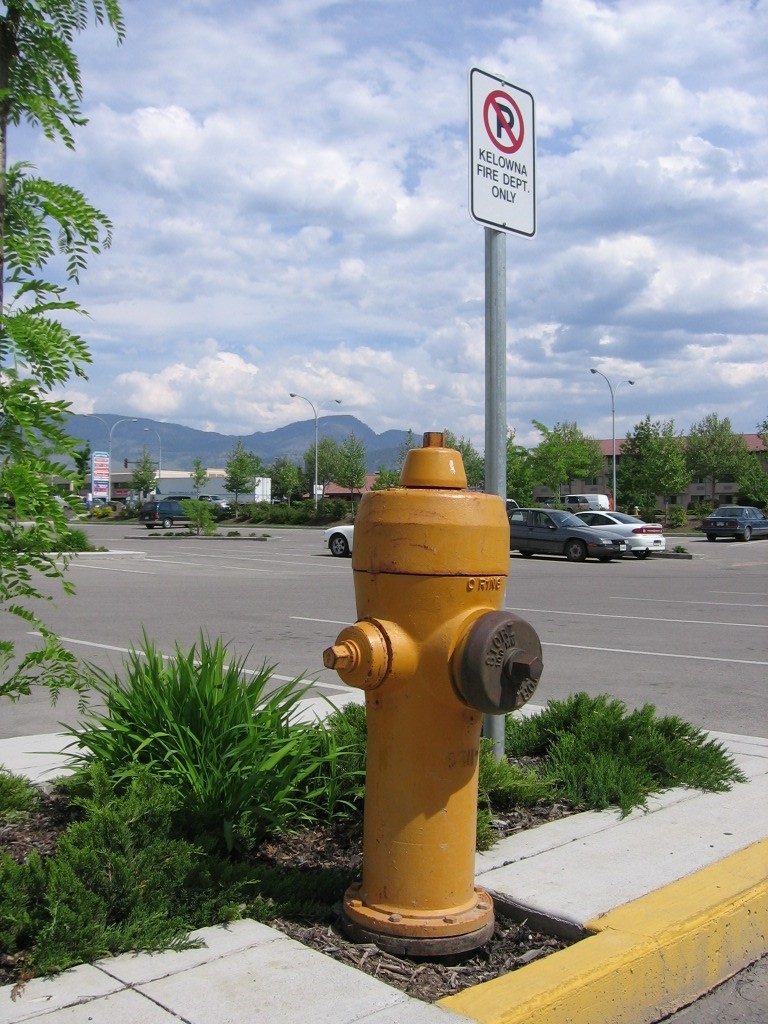Fire hydrants
Fire hydrants have been installed throughout Kelowna to ensure our crews have an accessible and adequate water supply when required for fire suppression.
Follow these guidelines to ensure firefighters can easily access a hydrant during an emergency:
- Don’t allow plants, shrubs, trees and snow to hide a fire hydrant
- Don’t park too close to a fire hydrant:
- A clear and unobstructed radius of one meter must be maintained around each fire hydrant or standpipe, and it must be possible to clearly view each hydrant or standpipe from the roadway while approaching from either direction
- Don’t attach manifolds and/or hoses to a hydrant without prior permission - BL8181 replaced sub-section 6.4(c)
- Don’t attach or connect anything to any hydrant or standpipe on public or private property without the authority of the Fire Chief and local water improvement district
- If you need to use water from a fire hydrant, call your water provider as listed on your bill and obtain a hydrant use permit. Please note that permits will not be issued for private hydrants.
Private hydrants can be found in private parking lots, industrial complexes, apartments and strata developments.
Private hydrants are to be used for fire suppression only. Permits will not be issued for any other use.

The City of Kelowna Water Utility doesn’t inspect or repair private hydrants. Please consult the yellow pages of your telephone book under Fire Protection & Prevention Consultants for a listing of companies that inspect and repair private hydrants.
The British Columbia Fire Code (Section 6.6.4. Hydrants) requires the owners of private hydrants to ensure the following:
- Hydrants shall be maintained in operating condition
- No person shall make any attachment or connection to any hydrant on public or private property without the authority of the Fire Chief and local water improvement district
- A clear and unobstructed radius of one meter must be maintained around each fire hydrant or standpipe, and it must be possible to clearly view each hydrant or standpipe from the roadway while approaching from either direction
- Hydrants shall be inspected at intervals not greater than 12 months and after each use
- The type, capacity, colour, location and maintenance of each fire hydrant on privately owned lands shall be subject to the approval of the Fire Chief. Records of inspections and tests on the hydrants shall be submitted to the Fire Chief on an annual basis and after each use.
- Hydrants shall be inspected to ensure that hydrant caps are in place, and caps with worn, rusted or obstructed threads that might hamper easy removal shall be repaired or replaced.
- Hydrant barrels shall be inspected to determine if water has accumulated as a result of a leaking main valve or a plugged or damaged drain valve.
- Main valves that are leaking and drain valves that are plugged or damaged shall be repaired (where it’s not practical to repair faulty drain valves or where drain valves are intentionally plugged, measures shall be taken to prevent the freezing of accumulated water)
- Hydrants shall be flushed at intervals not greater than 12 months with the main valve and any outlet valves fully opened until the water runs clear
- When re-painting hydrants, the barrel shall be painted Rustoleum Yellow (paint code 659)
- If the water flow is known the caps and top of the hydrant shall be painted as follows:
- 0 to 30 litres/second (0 to 500 USgpm): Weather-it Red (Paint code 10-222)
- 31 to 63 litres/second (500 to 1000 USgpm): Weather-it Orange (Paint code B54Z-400)
- 64 to 95 litres/second (1000 to 1500 USgpm): Weather-it green (Paint code 10-230)
- Greater than 95 litres/second (1500+USgpm): Weather-it Blue (Paint code 10-234)
- If the water flow is not known, contact your hydrant maintenance company as it may have to flow the hydrant to determine the flow. Records of the flow shall be submitted to the Fire Chief.
Hydrant paint colour specification table
| Hydrant part | Colour | Supplier | Supplier Colour | Supplier Code |
|---|---|---|---|---|
| Base | Black | Coal Tar Epoxy | ||
| Body | Yellow | General Paint | Hi-Vis Yellow | GP 202 |
| Cloverdale | Safety Yellow | Code 2589 | ||
| Rustoleum | Rustoleum Yellow | Code 659 | ||
| Caps and Bonnet | ||||
| 0-30 L/s | Red | General Paint | Signal Red | GP 208 |
| 0-500 USgpm | Cloverdale | Bright Red | Code 2505 | |
| Inadequate | Rustoleum | Rustoleum Red | Code 1210 | |
| 31-60 L/s | Orange | General Paint | Light Orange | GP 206 |
| 500-1,000 USgpm | Cloverdale | Hitachi Orange | Code 2521 | |
| Marginally adequate | Rustoleum | Rustoleum Orange | Code 956 | |
| 61-90 L/s | Green | General Paint | Signal Green | GP 214 |
| 1,000-1,500 USgpm | Cloverdale | Oliver Green | Code 2565 | |
| Good for residential | Rustoleum | Rustoleum Green | Code 1282 | |
| >90L/s | Blue | General Paint | National Blue | GP 209 |
| >1,500 USgpm | Cloverdale | Safety Blue | Code 2592 | |
| Very good flow | Rustoleum | Rustoleum Blue | Code 721-5D |



